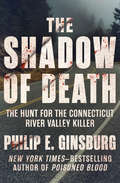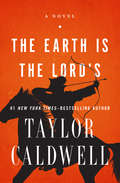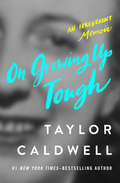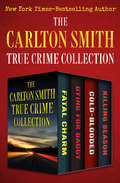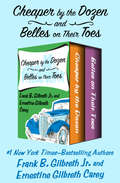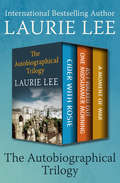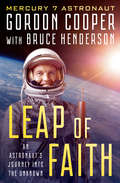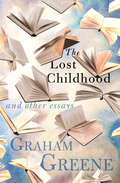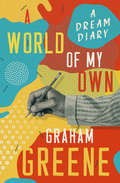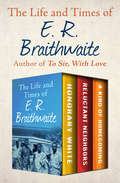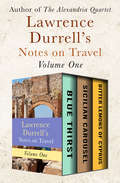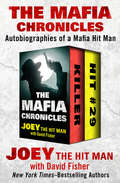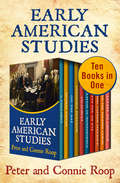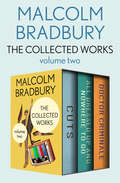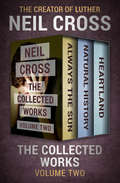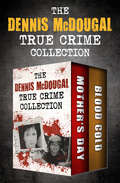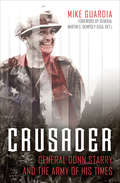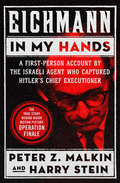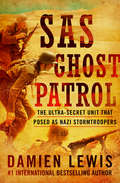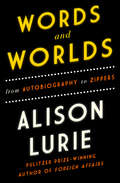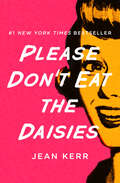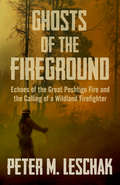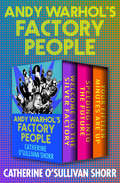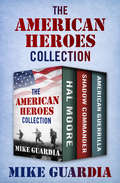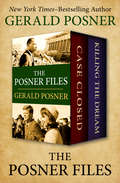- Table View
- List View
The Shadow of Death: The Hunt for the Connecticut River Valley Killer
by Philip E. GinsburgA riveting account of the search for a “latter-day Jack the Ripper” in New England: “Rich with characterization and insight, and a real page-turner” (Jonathan Kellerman). In the mid-1980s, someone stabbed six women to death in the Connecticut River Valley on the border between New Hampshire and Vermont. The murderer remains at large and the total number of his victims is unknown. In this brilliant work of true crime reportage, New York Times–bestselling author Philip E. Ginsburg provides fascinating insights into the groundbreaking forensic methods used to track the killer and paints indelible portraits of the lives he cut so tragically short. The Shadow of Death re-creates the fear that consumed the idyllic region when young women began to disappear with horrifying regularity. Neighbors used to leaving their doors unlocked suddenly wondered who among them was a sadistic serial killer. Friends and family of the victims were left to endure the bottomless pain of imagining their loved ones’ terrifying last moments. Desperate to stop the slayings, local police and FBI investigators used exotic new techniques to try to unmask the murderer. In some of the book’s most harrowing sections, Ginsburg documents the extraordinary efforts of psychologist John Philpin as he risks his own emotional stability to get inside the mind of a madman. Law enforcement officials identified several suspects and came tantalizingly close to putting all the pieces of the puzzle together, but it was only after a pregnant woman survived a brutal attack that the killings appeared to stop. The question remains: Could they start again? The Shadow of Death is a “riveting” profile of one of America’s greatest unsolved mysteries (Kirkus Reviews).
The Earth Is the Lord's: A Novel
by Taylor CaldwellFrom a #1 New York Times–bestselling author: A “magnificent” epic based on the early life of Genghis Khan (New York Herald Tribune). This sweeping saga captures life in the Far East during the Middle Ages and dramatizes the events that transformed a Mongol tribesman named Temujin into the man who would conquer Asia and be known to the world for centuries to come as Genghis Khan. Raised by an indomitable woman and educated by his outcast uncle, Temujin becomes a fearsome warrior who inspires loyalty in his friends and hatred in his enemies. But he is also blessed with a keen intelligence and the charisma of a natural born leader. In an era marked by treachery and savage violence, these gifts lead Temujin to a relentless pursuit of power. From the Gobi Desert to Samarkand, Taylor Caldwell transports readers to a distant world and shines a brilliant light on one of history’s most enigmatic figures. On her “huge historical canvas . . . blood spurts from the knife; beads of sweat stand out on straining flesh; lusts are consummated and revenges achieved” (New York Herald Tribune).
On Growing Up Tough: An Irreverent Memoir
by Taylor CaldwellThe #1 New York Times–bestselling author shares her rough journey to adulthood in a book that “should be read by every American” (Fort Wayne Journal-Gazette). Born in Manchester, England, in 1900, growing up wasn’t easy for Janet Taylor Caldwell. Her Scottish parents warned her that if she ever misbehaved at school, she’d be “thoroughly thrashed.” Weekends at home were filled with church and chores. When her family immigrated to America in 1907, life only got tougher. Her father died soon after their arrival in upstate New York, and the family struggled financially. But her mother, Anna, was a firm believer in Women’s Liberation and insisted that Janet could do a man’s job. With a first-class education, fierce self-reliance, and strong work ethic, Janet embarked on her writing career at the age of eight. Eventually, she was discovered by legendary editor Maxwell Perkins and began publishing under the name Taylor Caldwell. Her books sold millions of copies around the world and touched the lives of countless readers. Here is a witty and sharply observed account of the early struggles that gave Taylor Caldwell her strong convictions and made her one of the most distinctive voices in American literature. “You’re not likely to put this one down until the last line is devoured and digested” (Charleston Sunday News & Courier).
The Carlton Smith True Crime Collection: Fatal Charm, Dying for Daddy, Cold-Blooded, and Killing Season
by Carlton SmithFour chilling, true stories of murder from the Pulitzer Prize finalist and coauthor of New York Times bestseller, The Search for the Green River Killer. As an investigative journalist for the Seattle Times, Carlton Smith covered the Green River Killer case for over a decade. Smith, along with his coauthor, fellow reporter Tomas Guillen, were named Pulitzer Prize finalists for their New York Times bestseller, The Search for the Green River Killer, which was published ten years before Gary Ridgway was finally arrested for his crimes. Gathered here in this volume are four of Smith’s most engrossing accounts of serial killers, pathological liars, and shockingly cold-blooded murderers. Fatal Charm: When handsome, charming Randy Roth’s fourth wife drowned in a speedboating accident just weeks after their first anniversary, authorities began to look at a pattern of suspicious behavior, uncovering the lies of a serial wife killer. Dying for Daddy: Jack Barron’s wife died mysteriously in her sleep. Soon after, his two young children were also found dead in their beds. But only when his fifty-two-year-old mother died, also of asphyxiation in her sleep, did law enforcement officials finally take action against a man driven to commit the most unspeakable of acts. Cold-Blooded: When lawyer Larry McNabney disappeared, his wife claimed he joined a cult. By the time his body was found in a shallow grave three months later, Elisa McNabney was speeding toward a new life in Florida—and a brand-new identity. Beautiful, seductive, and ruthless, she had thirty-eight aliases and a rap sheet a mile long, but her run was about to end. Killing Season: Over the course of seven months in 1988, eleven women disappeared off the streets of New Bedford, Massachusetts. Nine turned up dead. Two were never found. And the perpetrator remains unknown. Smith provides a riveting account of the unsolved murders—and the botched investigation that let the New Bedford Highway Killer walk away.
Cheaper by the Dozen and Belles on Their Toes
by Ernestine Gilbreth Carey Frank B. Gilbreth Jr.The hilarious and heartwarming #1 New York Times bestseller and its beloved sequel about a larger-than-life family with twelve kids. Cheaper by the Dozen: Made into two classic movies—one starring Clifton Webb and the other starring Steve Martin—and translated into more than fifty languages, Cheaper by the Dozen is an amusing, endearing, and unforgettable memoir of the Gilbreth clan as told by siblings Frank Jr. and Ernestine Gilbreth. Mother and Dad are world-renowned efficiency experts, helping factories fine-tune their assembly lines for maximum output at minimum cost. At home, the Gilbreths themselves have cranked out twelve kids, and Dad is out to prove that efficiency principles can apply to family as well as the workplace—with riotous results. “A touching family portrait that also happens to be very, very funny.” —Jonathan Yardley, The Washington Post Belles on Their Toes: With twelve kids, life at the Gilbreth house has always been a big project. But after their father passes away, there are more challenges than ever. As their resourceful mother works to keep the family business running, the kids tackle the adventures of raising themselves and running a household. With the irrepressible blend of humor and good cheer characteristic of one of the most beloved families in America, the Gilbreths rise to every occasion and find a way to keep it all together. Belles on Their Toes was also made into a movie with Myrna Loy and Jeanne Crain reprising their roles. “There is a sincere and heartwarming atmosphere in this second volume that makes it almost better reading, if possible, than the first.” —Library Journal
The Autobiographical Trilogy: Cider with Rosie, As I Walked Out One Midsummer Morning, and A Moment of War (The Autobiographical Trilogy #3)
by Laurie LeeA young man’s journey—from the international bestselling account of his idyllic childhood in rural England to “a poetic memoir” of the Spanish Civil War (The Washington Post). In his acclaimed autobiographical trilogy, “one of the great writers of the twentieth century” presents a vivid portrait of coming of age in Europe between the wars (The Independent). Beginning with the international bestselling, lyrical memoir of his childhood in the Cotswolds, Laurie Lee follows up with a fascinating travel narrative of crossing England and Spain on foot, and brings the story to a climax with a gripping chronicle of his part in the Spanish Civil War. Cider with Rosie:International Bestseller Three years old and wrapped in a Union Jack to protect him from the sun, Laurie Lee arrived in the village of Slad in the final summer of the First World War. The cottage his mother had rented had neither running water nor electricity, but it was surrounded by a lovely half-acre garden and big enough for the seven children in her care. In this verdant valley tucked into the rolling hills of the Cotswolds, Lee learned to look at life with a painter’s eye and a poet’s heart—qualities of vision that, decades later, would make him one of England’s most cherished authors. “A remarkable book . . . dazzling.” —The New York Times As I Walked Out One Midsummer Morning: At age nineteen, Lee set out to walk the hundred miles from Slad to London, carrying only a change of clothes, his violin, a tent, a tin of biscuits, and some cheese. With a detour of an extra hundred miles to see the sea for the first time, Lee hopped a ferry to Spain because he knew enough Spanish to ask for a glass of water, and wandered the country for a year on foot. In one of the finest travel narratives of the twentieth century, Lee offers an unforgettable portrait of Spain on the eve of its civil war. “The vivid, sensitive, irresistibly readable story of what happened after [Lee] left home.” —The Daily Mail A Moment of War: Returning to a divided Spain in the bitter December of 1937 by crossing the Pyrenees from France, the idealistic young Lee came face to face with the reality of war, in this New York Times Notable Book. The International Brigade he sought to join was far from the gallant fighting force he’d envisioned but instead a collection of misfits without proper leadership or purpose. In a sudden confrontation with the enemy, he was left feeling anything but heroic. Captured more than once as a spy, Lee was lucky to escape with his life. “Written with brilliant economy and belongs to the remarkable literature which the Spanish Civil War inspired.” —The Independent
Leap of Faith: An Astronaut's Journey Into the Unknown
by Bruce Henderson Gordon Cooper“An exciting insider’s look at Projects Mercury, Gemini and Apollo . . . NASA’s internal politics, disasters, glitches and close calls” by a pioneering astronaut (Publishers Weekly). Gordon “Gordo” Cooper was one of the original Mercury Seven astronauts, pilot for Apollo X, head of flight crew operations for the United States’ first orbiting space station, and the last American to venture into space alone. Stretching from the dawning days of NASA to the far reaches of the unknown, Cooper’s distinguished career as a record-setting astronaut helped shape America’s space program and blazed a trail for generations to come. In this astonishing memoir—written with #1 New York Times bestseller Bruce Henderson—Cooper crosses paths with such aviation luminaries as Amelia Earhart, Wiley Post, and German rocket scientist Wernher von Braun; he shares his early days at Edwards Air Force Base and the endeavors that became the basis for The Right Stuff; he takes us inside NASA with candid accounts of his defeats and accomplishments; he reflects on the triumphs and tragedies of his heroic colleagues; and he finally reveals the reasons behind his belief in extraterrestrial intelligence, including the US military’s long-standing UFO cover-ups. Buckle yourself in for a breathtaking ride because in Leap of Faith, Gordon Cooper takes readers to places they’ve never been before.
The Lost Childhood: And Other Essays
by Graham GreeneFrom Dickens to Wilde—literary criticism and personal reflections by a master “unmatched . . . in his uncanny psychological insights” (The New York Times). Graham Greene shares his love affair with reading in this collection of essays, memories, and critical considerations, both affectionate and tart, “[that] could have come from no other source than the author of Brighton Rock and The Power and the Glory” (The Scotsman). Whether following the obsessions of Henry James, marveling at the “indispensible” Beatrix Potter, or exploring the Manichean world of Oliver Twist, Graham Greene revisits the books and authors of his lifetime. Here is Greene on Fielding, Doyle, Kipling, and Conrad; on The Prisoner of Zenda and the “revolutionary . . . colossal egoism” of Laurence Stern’s epic comic novel, Tristram Shandy; on the adventures of both Allan Quatermain and Moll Flanders; and more. Greene strolls among the musty oddities and folios sold on the cheap at an outdoor book mart, tells of a bizarre literary hoax perpetrated on a hapless printseller in eighteenth-century Pall Mall, and in the titular essay, reveals the book that unlocked his imagination so thoroughly that he decided to write forever. For Greene, “all the other possible futures slid away.” In this prismatic gallery of profound influences and guiltless pleasures, Greene proves himself “so intensely alive that the reader cannot but respond to the dazzling combination of intelligence and strong feeling” (Edward Sackville West).
A World of My Own: A Dream Diary
by Graham GreeneThe British author shares the “strange . . . inner layers of his playful, guilty imagination” in this glimpse into a brilliant novelist’s subconscious (The New York Times). Culled from nearly eight hundred pages of the author’s “dream diaries” kept between 1965 and 1989, this singular journal reveals “the feverish inner life of an intensely private man, providing an uncanny mirror-image of [his] novelistic obsessions, insecurities, and moral preoccupations” (Publishers Weekly). In what Greene calls My Own World—as opposed to the Common World of shared reality—he accompanies Henry James on a disagreeable riverboat trip to Bogota, is caught in a guerilla crossfire with Evelyn Waugh and W. H. Auden, strolls in the Vatican garden with Pope John Paul II who’s doling out Perugina chocolates like hosts, offers refuge to a suicidal Charlie Chaplin, and stages a disastrous play in blank verse for Elizabeth Taylor and Richard Burton. He also shares his headspace with Goebbels, Castro, Cocteau, Queen Elizabeth, D. H. Lawrence, and talking kittens. And the landscape is just as wide: from Nazi Germany to Haiti to West Africa to Bethlehem 1 AD and to Sweden where he seeks treatment for leprosy. Greene is a criminal, spy, lover, assassin, witness, and writer. Encompassing life, death, war, feuds, and career, and alternately absurdist, frightening, funny, and revealing, these fertile imaginings—many of which found their way into Greene’s fiction—comprise nothing less than “an alternate autobiography . . . a uniquely candid self-portrait” of one of the giants of English literature (Kirkus Reviews).
The Life and Times of E. R. Braithwaite: Honorary White, Reluctant Neighbors, and A Kind of Homecoming
by E. R. BraithwaiteThree compelling memoirs from the author of the “moving and inspiring” international bestseller, To Sir, With Love (The New York Times). E. R. Braithwaite wrote powerfully and poignantly about racial discrimination—both in his most famous novel, based on his own experience teaching in London’s East End, To Sir, With Love, which was made into a 1967 film starring Sidney Poitier—and in his candid nonfiction memoirs, three of which are collected here. Honorary White: In 1973, after the South African government lifted a long-standing ban on To Sir, With Love, Braithwaite was granted the official status of “Honorary White” for the length of his six-week visit. As such, he was afforded some of the freedoms that South Africa’s black population was denied, yet was nonetheless still considered inferior by the white establishment. In this “vivid” memoir, Braithwaite honestly presents his struggle with what he witnesses in South Africa under apartheid (The New York Times). Reluctant Neighbors: Sparked by the experience of sharing a train commute with a bigoted white neighbor, Braithwaite recounts a personal history of remarkable accomplishments in the face of racial intolerance and oppression, offering an unforgettable story of one man’s continuous struggle against injustice and his unwavering dedication to the pursuit of human dignity. A Kind of Homecoming: In the early 1960s, the British Guianese author embarked on a pilgrimage to the West African countries of Ghana, Guinea, and Liberia, and across Sierra Leone just as the emerging nation was preparing to declare its independence. Braithwaite discovered a world vastly different from the staid, firmly established British society in which he had spent most of his life. The sights, sounds, and smells of West Africa vividly reawakened lost memories from his childhood. Entering the intimate circles of the local intelligentsia, he was able to view these newly evolving African societies from the inside, struck by their mixtures of passion and naïveté, their political obsessions and technological indifference. He discovered a world that fascinated, excited, and, in some cases, deeply troubled him—and in the process he discovered himself.
Lawrence Durrell's Notes on Travel Volume One: Blue Thirst, Sicilian Carousel, and Bitter Lemons of Cyprus
by Lawrence DurrellTravel writing “as luminous as the Mediterranean air” from the acclaimed author of the Alexandria Quartet, who is featured in PBS’s The Durrells in Corfu (Time). Born in India, acclaimed British novelist and poet Lawrence Durrell lived in Corfu as a young man, enjoying salt air, cobalt water, and an unfettered bohemian lifestyle, along with his brother, Gerald, who would also go on to be a writer and a naturalist. Their real-life family is portrayed in the PBS Masterpiece production, The Durrells in Corfu. Over the following decades, he rambled around the Mediterranean, making homes in Egypt, Cyprus, and Greece, always bringing his poet’s eye to document his experiences. Blue Thirst: In the first of a pair of lectures, given during a 1970s visit to California, Durrell recalls his family’s time living on the Greek island of Corfu, expanding on his eloquent memoir, Prospero’s Cell. When the Second World War came to the Mediterranean, Durrell was swept into diplomatic service, an adventure he vividly recounts in his powerful second lecture. “[Durrell’s] travel books arrive like long letters from a civilized and very funny friend.” —Time Sicilian Carousel: For years, Durrell’s friend Martine had begged him to visit her on the sun-kissed paradise of Sicily, but it took her sudden death to finally bring him to the island’s shores. With Martine’s letters in his pocket, Durrell treks from sight to sight, dizzy with history and culture, and finds haunting echoes of his past lives in Rhodes, Cyprus, and Corfu. “Elegant . . . wonderful.” —Time Bitter Lemons of Cyprus: Against the backdrop of the push for independence on Cyprus in the early 1950s, the poet, novelist, and former British government official buys a house, secures a job, and settles in, yearning for a return to the island lifestyle of his youth. Winner of the Duff Cooper Prize, this memoir is an elegant picture of island life in a changing world. “Brilliant depth of language . . . gathering slowly from the lighter delightful pages to its lost and questioning end. Never for a moment does [Durrell] lose the poet’s touch.” —The New York Times
The Mafia Chronicles: Autobiographies of a Mafia Hit Man
by David Fisher Joey the Hit ManA New York Times bestseller, the “chilling and compelling . . . must-read” confessions of a mob hit man—and the riveting sequel of his most harrowing contract (former FBI agent Joe Pistone, aka Donnie Brasco). Killer: The Bronx-born son of a Jewish bootlegger, “Joey the Hit Man” was introduced to crime when he was just eleven years old. For the next thirty years he was a numbers king, scalper, loan shark, enforcer, and drug smuggler. He hijacked trucks, fenced stolen goods, and trafficked in pornography. But Joey really made his name as a Mafia assassin, racking up thirty-eight cold-blooded hits—thirty-five for cash, three for revenge. In this no-holds-barred account, he reveals the brutal truth of a life in organized crime. Hit #29: In the fall of 1969, a public execution in a Brooklyn Italian restaurant earned Joey a mention in the New York Daily News and a twenty-grand payout from the mob. Next up: The bosses suspected their trusted numbers controller, Joe Squillante, was skimming the nightly bets to settle personal debts. But Squillante, aka Hit #29, was no clueless patsy and an unpredictable bull’s-eye. Taking the job meant entering into a game of predator and prey as nerve-racking as the cock of a .38 hammer.
Early American Studies: Ten Books in One (Palgrave Studies In Theatre And Performance History #Vol. 21)
by Peter Roop Connie RoopAmerican history comes alive for young readers in this collection of richly detailed narratives ranging from Christopher Columbus to Abraham Lincoln. These “direct and surprisingly accessible” histories, often told in the actual words of key figures from the American past, are a brilliant blend of fact and imagination (Publishers Weekly). I, Columbus: A firsthand account of Christopher Columbus’s famous voyage to the East, taken directly from his journal entries. He tells of excitement, drama, and terror on the high seas, as he and his crew weather the path to discovery. Pilgrim Voices: The pilgrims’ own writings of their voyage on the Mayflower, their first encounters with indigenous people, and their Thanksgiving celebration after surviving a difficult first winter in the New World. Off the Map: The story of Lewis and Clark’s famous 1804 expedition into the uncharted lands of America, in an accessible version drawn from the explorers’ own account. Louisiana Purchase: Biographical sketches of Lewis and Clark, Napoleon Bonaparte, and Thomas Jefferson tell the story of the United States’ expansion into a new territory and a new era. Sacagawea: Told from Sacagawea’s point of view, this historical novel shares the ordeals of her youth along with the memory of her journey west with Lewis and Clark. She shares her love of nature and explains how her loyalties have changed over time. The Declaration of Independence: Covering major events such as the Boston Massacre and Paul Revere’s midnight ride, this accessible history brings the story of the Revolutionary War to life. An Eye for an Eye: When her brother is captured at the start of the Revolutionary War, fourteen-year-old Samantha sets off to rescue him. But when she comes face-to-face with the enemy, will she still stand by her peaceful principles? Take Command, Captain Farragut!: Ten-year-old David Glasgow Farragut is the youngest midshipman ever assigned to a warship in the US Navy. Told through fictional letters that Farragut writes from prison after his capture in the War of 1812, this richly imagined story is based on real history. Ahyoka and the Talking Leaves: Ahyoka’s father is a Cherokee silversmith who dreams of a written language for his people. When he is ostracized for the “magic” he is creating, father and daughter leave home to pursue his dream on their own. Grace’s Letter to Lincoln: After seeing Abraham Lincoln on a poster, eleven-year-old Grace decides to write to him and suggest that he might win more votes in the 1860 election if he grows a beard. Much to her surprise, Lincoln answers her letter, and history is made. This “touching historic encounter” is based on true events (Scholastic).
The Collected Works Volume Two: Cuts, All Dressed Up and Nowhere to Go, and Doctor Criminale
by Malcolm BradburySharp-witted novels and social commentary by the beloved British critic, teacher, and author of the “outstanding” comic masterpiece, The History Man (The Guardian). “A satirist of great assurance and accomplishment,” Malcolm Bradbury remains one of the sharpest comic minds of the twentieth century (The Observer). Cuts and Doctor Criminale—like “all Bradbury’s novels, for all their surface wit and comedy, have serious moral and philosophical subtexts” (The Guardian), as do his barbed and brilliant observations on 1950s culture shock in Great Britain in All Dressed Up and Nowhere to Go. Taken together, these three volumes illustrate the myriad ways “Bradbury dazzles” (Kirkus Reviews). Cuts: In Bradbury’s “outrageously funny” satire set in Thatcher-era Great Britain, a media tycoon, looking to strike it rich with television gold, recruits an unassuming novelist and academic to script his small-screen epic, with disastrous—and hilarious—consequences (Publishers Weekly). “It is funny, exact—and pretty bloody serious.” —The Observer All Dressed Up and Nowhere to Go: In this nonfiction social commentary, Bradbury confronts a curious moment in British history. After teaching abroad for a year in the 1950s, he returned to find that his native country had become nearly as mystifying to him as the American Midwest. As Britain marched toward a new decade, much of the country was changing rapidly, its agrarian past paved over by suburban developer and its quiet traditionalism replaced by beehive hairdos and shiny, glass-walled office buildings. With wry wit, he reacts to this uncomfortable transition to mid-twentieth-century modernism. “A master not only of language and comedy but of feeling too.” —The Sunday Times Doctor Criminale: “Playful, smart and entertaining,” Bradbury’s comic novel follows enterprising young reporter Francis Jay as he attempts to navigate the chaotic world of post–Cold War Europe in pursuit of the specter of literary legend Bazlo Criminale, a mysterious novelist and thinker known for his extreme elusiveness (The New York Times Book Review). “Bradbury writes with splendid energy and a fertile mind.” —Los Angeles Times Book Review
The Collected Works Volume Two: Always the Sun, Natural History, and Heartland
by Neil CrossTwo taut psychological thrillers and a gripping memoir from the creator of the hit BBC crime series Luther and a “master of suspense” (Daily Mirror). The PEN/Ackerley Prize–shortlisted author and creator of Luther starring Idris Elba, British author Neil Cross is “an astonishing writer—tautly lyrical, and able at a stroke to fill you with cold, dark fear of the malign forces at large in the world” whether writing fiction or memoir (Time Out London). In this collection, Cross unflinchingly explores the dark side of parenting and family drama in ways equally startling and unforgettable. Always the SunLonglisted for the Man Booker Prize Looking for a fresh start after the death of his wife, Sam and his thirteen-year-old son, Jamie, return to Sam’s hometown. But at his new school, a group of kids led by a savage bully target Jamie, and the administration does nothing. When Jamie comes home bearing real, physical scars, Sam is left at a crossroads: How far will he go to protect his child? “Harrowing but gripping.” —Time Out London Natural History: In a last-ditch attempt to save their floundering marriage, Patrick and Jane founded an animal sanctuary called Monkeyland. But following the mysterious death of an ape, Patrick becomes obsessed, while Jane’s in Zaire shooting a nature show—and possibly cheating—and their son gets fired after an altercation. As a predatory cat stalks the periphery of the dilapidated zoo, Jane and Patrick’s search for wild beasts blinds them to the danger in their own backyard. “A masterpiece . . . seductively readable, no matter how much one dreads what may happen next.” —The Daily Telegraph HeartlandShortlisted for the PEN/Ackerley Prize In this “wonderful memoir,” Neil Cross tells the complicated story of his relationship with his stepfather. Derek Cross showers his young stepson with attention and love, teaches him about music and books, and is more reliable than Neil’s emotionally unstable mother. But as Neil grows older, he realizes the stepfather he loves is also a manipulator, adulterer, racist, and con man (The Guardian). “Moving and engrossing . . . Heartland is a tour de force.” —Daily Mail
The Dennis McDougal True Crime Collection: Mother's Day and Blood Cold
by Dennis McDougalFrom a murderous mother to a famous actor accused of killing his wife in cold blood, gripping true crime exposés from an award-winning journalist. Mother’s Day: The true story of Theresa Cross Knorr, the twisted child abuser who murdered two of her own daughters—with the help of her sons. It would be almost a decade after these horrific crimes before her youngest daughter, Terry Knorr Graves, revealed her mother’s history of unfathomable violence. At first, she was met with disbelief by law enforcement and even her own therapist, but eventually, the truth about her mother’s monstrous abuse emerged. Award-winning journalist Dennis McDougal details the pathological jealousy, rage, and domineering behavior that escalated into appalling acts of homicide and destroyed a family. Blood Cold: In May 2001, Bonny Lee Bakley was shot to death in a car parked on a dark Hollywood side street. Eleven months later, Robert Blake—her husband, the father of her child, and the star of the classic film In Cold Blood and the popular 1970s TV detective series Baretta—was arrested for murder, conspiracy, and solicitation. Did Blake kill his wife? Did he hire someone to do the job for him? Award-winning journalist Dennis McDougal and entertainment-media expert Mary Murphy recount a real-life crime story more shocking and bizarre than any movie.
Crusader: General Donn Starry and the Army of His Times
by Mike GuardiaThe biography of US Army general Donn Starry, creator of the AirLand Battle doctrine that led to victory in Operation Desert Storm. Donn Starry, one of the most influential commanders of the Vietnam War, went on to become one of the “intellectual giants” who reshaped the US Army and, throughout his career, worked to improve training, leadership, and conditions for the men who served under him. Starry was a leading advocate for tank warfare in Vietnam. His recommendations helped shape the American armor position in Southeast Asia and paved the way for his success as commander of the 11th Armored Cavalry during the invasion of Cambodia. As commander of Fort Knox and the US Army Armor School in the 1970s, Starry brought new advances to armor tactics, training, and strategy. Most notably, he created the new “AirLand Battle” doctrine, which paved the way for a decisive US victory in the Gulf War. Like most Vietnam-era commanders, Starry’s legacy has been overshadowed by the controversy surrounding the war itself—but few have had as much of an impact on modern maneuver warfare. In this new biography of Gen. Donn Starry, armor officer Mike Guardia examines the life and work of this pioneering officer using extracts from interviews with veterans and family, as well as from Starry’s personal papers.
Eichmann in My Hands: A First-Person Account by the Israeli Agent Who Captured Hitler's Chief Executioner
by Harry Stein Peter Z MalkinThe true story behind “one of history’s great manhunts” and the film Operation Finale by the Mossad legend who caught the most wanted Nazi in the world (The New York Times). 1n 1960 Argentina, a covert team of Israeli agents hunted down the most elusive war criminal alive: Adolf Eichmann, chief architect of the Holocaust. The young spy who tackled Eichmann on a Buenos Aires street—and fought every compulsion to strangle the Obersturmführer then and there—was Peter Z. Malkin. For decades Malkin’s identity as Eichmann’s captor was kept secret. Here he reveals the entire breathtaking story—from the genesis of the top-secret surveillance operation to the dramatic public capture and smuggling of Eichmann to Israel to stand trial. The result is a portrait of two men. One, a freedom fighter, intellectually curious and driven to do right. The other, the dutiful Good German who, through his chillingly intimate conversations with Malkin, reveals himself as the embodiment of what Hannah Arendt called “the banality of evil.” Singular, riveting, troubling, and gratifying, Eichmann in My Hands “remind[s] of what is at stake: not only justice but our own humanity” (New York Newsday). Now Malkin’s story comes to life on the screen with Oscar Isaac playing the heroic Mossad agent and Academy Award winner Ben Kingsley playing Eichmann in Operation Finale.
SAS Ghost Patrol: The Ultra-Secret Unit That Posed as Nazi Stormtroopers
by Damien LewisAn “amazing” account of Britain’s most audacious act of subterfuge in WWII: an undercover raid of Rommel’s stronghold in Tobruk (The Daily Mirror). On a scorching September day in 1942, the Special Air Service (SAS), a special forces unit of the British Army, pulled off one of the most daring, top-secret ruses of the Second World War. The plan (sanctioned by Churchill): cover a grueling two thousand miles of the Sahara desert to attack German general Erwin Rommel’s seemingly impregnable port fortress in North Africa from the rear to break free and arm more than thirty thousand Allied POWs. Led by Capt. Herbert Buck and posing as Afrika Korps soldiers complete with German uniforms and weaponry, the crew broke into the enemy stronghold Trojan Horse–style as part of the coordinated attack on Tobruk. “Intensively researched . . . powerfully written,” and culled from the private diaries of the do-or-die maverick heroes, this extraordinary story of the sneak attack on the notorious Desert Fox is more thrilling than any fiction. A bold, outrageous, and rule-shattering mission impossible, SAS Ghost Patrol is “one of the great untold stories of WWII” (Bear Grylls).
Words and Worlds: From Autobiography to Zippers
by Alison LuriePoignant remembrances and sharp observations from the “most able and witty” Pulitzer Prize–winning author of Foreign Affairs (The New York Times). This engaging new collection of essays from the New York Times–bestselling novelist gathers together her reflections on the writing life; fond recollections of inspiring friends; and perceptive, playful commentary on preoccupations ranging from children’s literature to fashion and feminism. Citing her husband’s comment to her that “Nobody asked you to write a novel,” Lurie goes on to eloquently explain why there was never another choice for her. She looks back on attending Radcliffe in the 1940s—an era of wartime rations and a wall of sexism where it was understood that Harvard was only for the men. From offering a gleeful glimpse into Jonathan Miller’s production of Hamlet to memorializing mentors and intimate friends such as poet James Merrill, illustrator Edward Gorey, and New York Times Book Review coeditor Barbara Epstein, Lurie celebrates the creative artists who encouraged and inspired her. A lifelong devotee of children’s literature, she suggests saying no to Narnia, revisits the phenomenon of Harry Potter, and tells the truth about the ultimate good bad boy, Pinocchio. Returning to a favorite subject, fashion, Lurie explores the symbolic meaning of aprons, enthuses on how the zipper made dressing and undressing faster—and sexier—and tells how, feeling abandoned by Vogue at age sixty, she finally found herself freed from fashion’s restrictions on women. Always spirited no matter the subject, Lurie ultimately conveys a joie de vivre that comes from a lifetime of never abandoning her “childish impulse to play with words, to reimagine the world.”
Please Don't Eat the Daisies
by Jean KerrThe “refreshing . . . laugh-out-loud” #1 New York Times bestseller about life in the suburbs that was adapted into a classic film comedy (Kirkus Reviews). One day, Tony Award–winning playwright Jean Kerr packed up her four kids (and husband, Walter, one of Broadway’s sharpest critics), and left New York City. They moved to a faraway part of the world that promised a grassy utopia where daisies grew wild and homes were described as neo-gingerbread. In this collection of “wryly observant” essays, Kerr chronicles her new life in this strange land called Larchmont (TheWashington Post). It sounds like bliss—no more cramped apartments and nightmarish after-theater cocktail parties where the martinis were never dry enough. Now she has her very own washer/dryer, a garden, choice seats at the hottest new third-grade school plays (low overhead but they’ll never recoup their losses), and a fresh new kind of lunacy. In Please Don’t Eat the Daisies “Jean Kerr cooks with laughing gas” as she explores the everyday absurdities, anxieties, and joys of marriage, family, friends, home decorating, and maintaining a career—but this time with a garage! (Time).
Ghosts of the Fireground: Echoes of the Great Peshtigo Fire and the Calling of a Wildland Firefighter
by Peter M LeschakIn October 1871, a massive forest fire incinerated the town of Peshtigo, Wisconsin. It was the deadliest fire in North American history, an event so intense that its release of energy was not approximated until the advent of thermo-nuclear weapons. At least 1,200 people perished—some in bizarre and disturbing ways—and the actual number of fatalities is unknown, perhaps as many as 1,500 were lost. Since the Great Chicago Fire occurred at the same time, Peshtigo was overshadowed and almost forgotten. In 2000, veteran wild-land firefighter Peter Leschak was faced with a hot and challenging fire season, tasked with the leadership of a helitack crew—an airborne fire team expected to be the “tip of the spear” on wildfire initial attacks. During that long summer he studied Father Peter Pernon’s eyewitness account of the Pehstigo holocaust, and using his knowledge and experience as a firefighter, Leschak placed himself in Pernin’s shoes, as much as possible being transported to the firestorm of 1871. Ghosts of the Fireground tells both tales: the horrific saga of Peshtigo, and the modern battles of a wildfire helicopter crew, seamlessly intertwining the stories to enhance them both.
Andy Warhol's Factory People: Welcome to the Silver Factory, Speeding into the Future, and Your Fifteen Minutes Are Up (Andy Warhol's Factory People #2)
by Catherine O'Sullivan ShorrBased on the television documentary: A three-part oral history of the Pop Art sensation’s inner circle and their dazzling world of art, drugs, and drama. Featuring a new introduction by the author, special to this collection, this three-part companion volume to Emmy Award–winning Catherine O’Sullivan Shorr’s documentary Andy Warhol’s Factory People is an unprecedented exposé of an exhilarating and tumultuous time in the 1960s New York City art world—told by the artists, actors, writers, musicians, and hangers-on who populated and defined the Factory. “Different [in] its avowed bottom-up approach: Warhol as a function of his followers is the idea. This time . . . it’s the interviews that tell the tale” (Robert Lloyd, Los Angeles Times). Welcome to the Silver Factory: In 1962, frustrated with advertising work, Warhol sets up his legendary studio in an abandoned hat factory on Manhattan’s 47th Street. The “Silver Factory” quickly becomes the hub of Warhol’s creative endeavors—the space where he constantly works while an ever-changing cast of characters and muses passes through with their own contributions. Speeding into the Future: In a peak period from 1965 through 1966, Warhol creates the notion of the “It Girl” with ingenuous debutante Edie Sedgwick; discovers Lou Reed, the Velvet Underground, and Nico, the gorgeous chanteuse who becomes his next “It Girl”; and directs—with Paul Morrissey—his most commercially successful film, the art house classic, Chelsea Girls. Your Fifteen Minutes Are Up: By 1967, it seems that the Factory has outlived its fifteen minutes of fame. Superstars like Edie Sedgwick fall victim to drugs. Factory denizens have falling-outs with Warhol, as do the Velvet Underground, who are also caught up in disputes of their own. Into the chaos comes radical feminist Valerie Solanas, who shoots Warhol and seriously injures him. He survives—barely—but the artist, and his art, are forever changed.
The American Heroes Collection: Hal Moore, Shadow Commander, and American Guerrilla
by Mike GuardiaThree stirring military portraits—including a biography of the Vietnam War hero who wrote the New York Times bestseller, We Were Soldiers Once . . . and Young. Hal Moore: A heroic commander in the Vietnam War, Harold G. Moore cowrote the New York Times–bestselling memoir of the battle at Ia Drang and was portrayed by Mel Gibson in the film We Were Soldiers. This “outstanding” and definitive biography expands on the account of that pivotal battle to encompass Moore’s distinguished military career from the Korean War through his courageous and invaluable service in Vietnam (Armchair General). Shadow Commander: In World War II, US Army legend Donald Blackburn escaped from Bataan along with Russell W. Volckmann and organized the guerrilla fighters known as “Blackburn’s Headhunters” against the Japanese. He would go on to play a key role in the Vietnam War, revitalizing Army Special Forces operations in Southeast Asia, spearheading Operation White Star in Laos, and eventually taking command of the highly classified Studies and Observations Group (SOG). Blackburn was also the architect of the infamous Son Tay Prison Raid, officially termed Operation Ivory Coast, the largest prisoner-of-war rescue mission of the Vietnam War. “A follow-up to a fine bio of Russell Volckmann, this tale of guerrilla warfare spans from Bataan to Vietnam.” —World War II Magazine American Guerrilla: Here is Russell Volckmann’s own story, from his refusal to surrender at Bataan to raising a Filipino army of more than twenty-two thousand men and leading a guerrilla war against the Japanese for the next three years. When General Yamashita finally surrendered, he made his initial overtures not to General Douglas MacArthur, but to Volckmann. The progenitor of modern counterinsurgency doctrine, Volkmann wrote the field manuals that became the US Army’s first handbooks outlining the precepts for both special warfare and counter-guerrilla operations, making him the true “father” of Army Special Forces. “[Volckmann’s private army] waged arguably the most successful guerrilla campaign of the entire war . . . Mr. Guardia argues, convincingly, that Volckmann deserves the title of ‘father’ of Special Forces.” —The Washington Times
The Posner Files: Case Closed and Killing the Dream
by Gerald PosnerDefinitive accounts of JFK’s and Martin Luther King’s assassinations by a Pulitzer Prize finalist and New York Times–bestselling author. Case Closed: A Pulitzer Prize finalist and New York Times bestseller, Case Closed is a vivid and straightforward account that stands as one of the most authoritative books on the assassination of John F. Kennedy. Drawing from official sources and dozens of interviews, filled with powerful historical detail, and including an updated comment for the fiftieth anniversary, Posner’s “utterly convincing” book lays to rest all of the convoluted conspiracy theories—concerning the mafia, a second shooter, and the CIA—that have obscured what really happened in Dealey Plaza on November 22, 1963 (Chicago Tribune). “By far the most lucid and compelling account . . . of what probably did happen in Dallas—and what almost certainly did not.” —The New York Times Book Review Killing the Dream: On April 4, 1968, Martin Luther King Jr., was killed in Memphis, Tennessee, by a single assassin’s bullet. James Earl Ray was seen fleeing from a rooming house that overlooked the hotel balcony where King was shot. An international manhunt ended two months later with Ray’s capture. Though Ray initially pled guilty, he quickly recanted and for the rest of his life insisted he was an unwitting pawn in a grand conspiracy. In Killing the Dream, expert investigative reporter Gerald Posner cuts through phony witnesses, false claims, and a web of misinformation to put Ray’s conspiracy theory to rest and disclose what really happened the day King was murdered. “A superb book: a model of investigation, meticulous in its discovery and presentation of evidence, unbiased in its exploration of every claim. And it is a wonderfully readable book, as gripping as a first-class detective story.” —The New York Times
